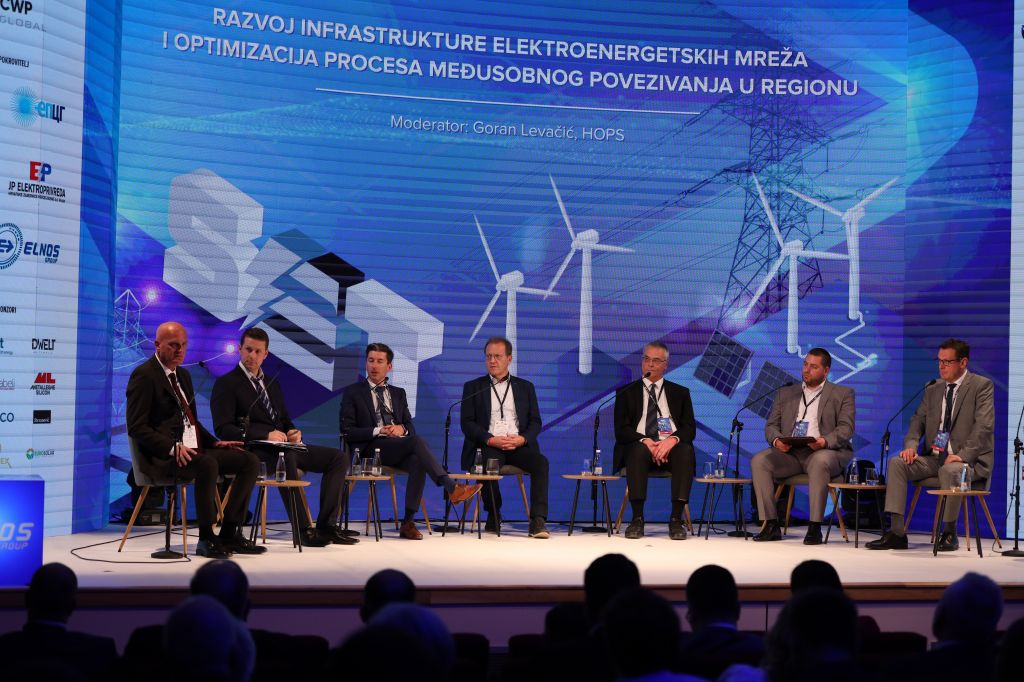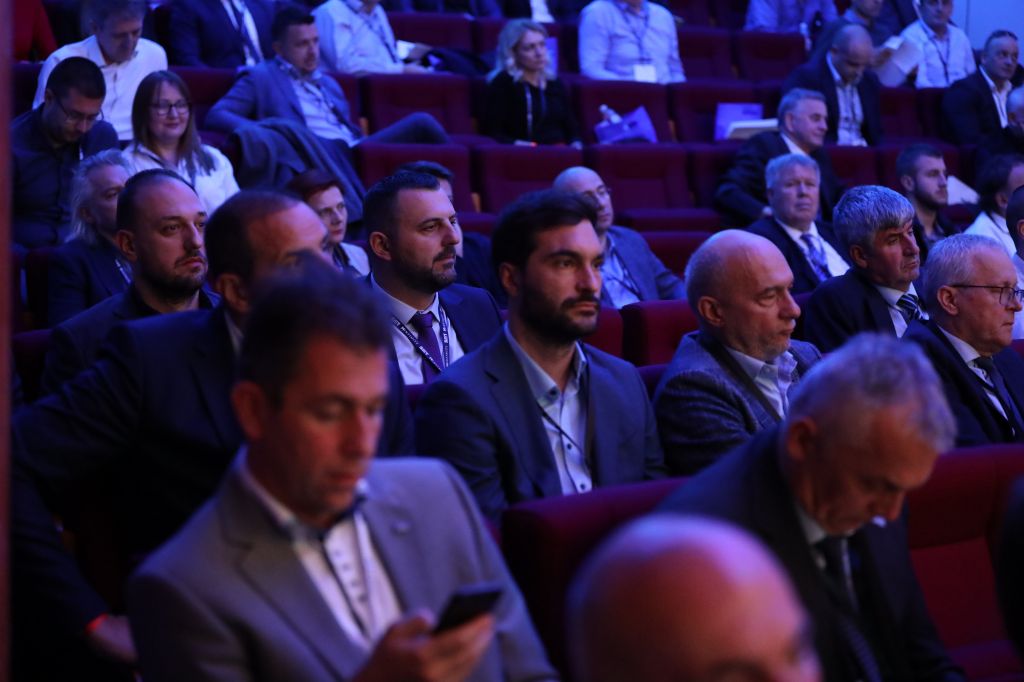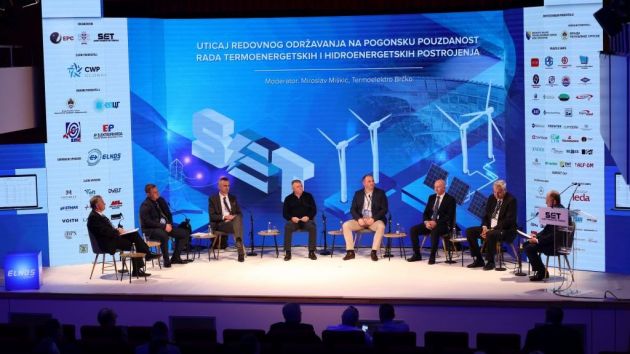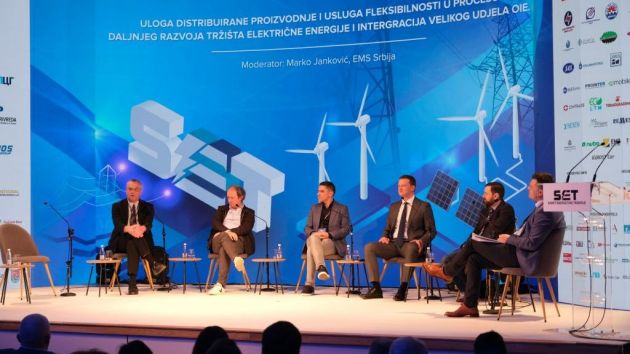SET 2023: True Investors in Development of Infrastructure of Electrical Energy Networks Need to Be Recognized
Source: eKapija
 Thursday, 30.03.2023.
Thursday, 30.03.2023.
 09:59
09:59
 Thursday, 30.03.2023.
Thursday, 30.03.2023.
 09:59
09:59
(Photo: SET/3D Media)

Due to the increasing urbanization, spatial limitations and problems with getting new corridors, new technological solutions need to be envisaged as early as the planning stage. New technology is crucial to realizing those ambitious goals. It is precisely the European Commission that recently adopted two legal frameworks – an act on the clean technologies industry, which aims for zero emissions until 2050, and the reform of the electrical energy market, whose principal role is to protect the consumers, regulate the prices, introduce new technologies…
In order for the networks to be able to function in a safe and stable manner in the future, they are expected to be flexible and resilient to new circumstances. At the panel titled “Development of the Infrastructure of Electrical Networks and Optimization of the Interconnection Process in the Region”, at this year’s SET, the participants tried to provide answers to some of the questions.
– When it comes to the biggest challenges that Croatia is currently facing in the transfer system, it is primarily the problem of connecting to the network, that is, a large number of sources are trying to connect – concentrated in the geologically very narrow area between Rijeka and Dubrovnik, pertaining to the interest and hints at the connecting of some offshore structures in the north Adriatic area. We are working intensively on adapting the legal regulations in order to facilitate the connecting of new renewable sources. Considering all of the above, the existing network is not sufficient and we are working on building a new corridor on the north-south stretch at a rapid pace, so as to integrate all the potential connections – pointed out the moderator of the panel and a representative of HOPS, Goran Levacic.
The situation in Slovenia is similar, but there are also differences, added Simon Tot of the company ELES Slovenia.
– In fact, we have two structures. When it comes to the transfer, it’s more or less ok, because it’s part of an international network and provides some stability. We have already made some steps toward adapting the network for new renewable sources and preparing for what awaits us in this transition, which is in full swing. On the other hand, there are problems with the distribution. It’s a big question how to solve the big pressure regarding the implementation of new features. Everybody is interested in having a solar power plant on the roof, and we have nearly reached the upper limit in that respect, so something needs to be done there. Furthermore, we have an additional problem – due to the increased number of heating pumps powered by various fuels – gas, biomass and others, which everybody wants to replace with pumps powered by renewable sources. An additional problem is the incompatibility of these two types of pumps. If we add to all this the problem of charging the cars, it’s high time we seriously looked into the problem of switching from the distribution system to the system of storage and transfer of this energy – he specified.
North Macedonia has it similar as the other countries of the Western Balkans – there are many investors interested in transitioning to renewable energy sources, pointed out the representative of this country, Nikola Rilak, the deputy general director of MEPSO.
– We have received more than 70 requests for connection with a power of 7,500 MW, of which 1,300 MW are wind generators, and 6,200 MW are photovoltaic power plants. So far, we have issued permits for 400 MW, with the tendency to connect another 500 to 1,000 MW from both renewable sources by the end of the year. If we take into consideration the interest of the investors for connecting to new energy sources, our capacities exceed the green strategy. We are actively involved in the national energy development strategy, creating the conditions for the integration of potential renewable sources. The integration of renewable sources is a great challenge for us, because power plants have a negative impact on the transfer systems. The main challenge for us is the optimal transfer infrastructure for connecting. Renewable sources have a variable production profile, and systemically that entails bigger power reserves and frequent activations of electrical energy for balancing.
(Photo: SET/3D Media)

When it comes to Bosnia and Herzegovina, the maximum reception power from wind farms and solar power plants was removed in May last year. Connecting is done in accordance with the Rulebook on the Connection of Renewable Sources of Bosnia and Herzegovina.
– According to the Rulebook on Power Transfer of Bosnia and Herzegovina, the obligation is to run a list of submitted requests. According to that list, nearly 200 requests for facilities have been made, of which: 125 solar, 46 wind, 15 hydro and 9 thermal power plants. It’s interesting that there are nine requests for thermal power plants. That doesn’t mean that those facilities will be built and connected, but they did apply their status for power transfer. In the connection process, there are several steps – the preparation of a study, the obtaining of an authorization and the signing of an agreement on connection. The connection fee has a fixed component and a variable component. The variable component consists of the costs which were incurred until the connection to the network, and the fixed components is the compensation for creating the conditions on the network. The fixed component amounts to 50 convertible marks per KWh. The rulebook was made in 2008 and nobody was giving incentives for renewable sources in BiH at the time. We recognized that renewable sources were a special thing and, due to the importance of those projects, we already then provided a 50% discount on the fixed component of the fee. These discounts, for hydro power plants, pertain only to facilities up to 10 MW. Considering this list, the problem is how to recognize true and serious investors – Sasa Scekic of the State Electricity Regulatory Commission of Bosnia and Herzegovina (DERK BiH) explained the procedures in BiH.
Davor Bajs, an expert at the Energy Community Secretariat, points out that this body was formed on the basis of the agreement between the EU and the then countries of the Western Balkans which wanted to join the EU.
– At the moment, in addition to these 6 countries which want to joint, the Energy Community is expanded by another three eastern countries. Declaratively and in practice, they adapt and implement the directives and the legislative framework of the EU for energy. This is the third package of energy laws and they are mostly implemented in our community. What we are not satisfied with is the speed, that is, the slowness of the procedure. If we’re talking about infrastructure, the regulations related to the Trans-European Networks for Energy (TEN-E) from 2013 were adopted here in 2015, with 2016 as the deadline for the implementation. In most of those countries, it has not yet been implemented in their national legislative framework. We’re talking a delay of seven years. At the Ministerial Council last year, a new range of laws on electrical energy was adopted, including the Law on the Internal Electrical Energy Market, and before that the Law on Renewable Energy Sources. In the conditions when the third package of laws has not been implemented in national legislatives, now there’s a four package arriving, which will certainly be a challenge. We hope that the implementation in each country will go faster than has been the case so far.
When it comes to building the infrastructure, ELNOS GROUP from Banjaluka has incredible engineering in many countries of the region and outside it. In order to achieve this global success, they’ve had to face many challenges.
– We are one of the oldest companies in the region in the field of investments and construction of the infrastructure. In the beginning, we worked intensively on the construction of the infrastructure for thermal and hydro potentials, and now we’re facing a new investment cycle, which is partially based on decarbonization, and partially on the share of electrical energy in the overall energy balance of Europe – pointed out the vice president of ELNOS GROUP, Borko Torbica.
He adds that, due to the most recent events, that is, the reduced distribution of gas and energy from Ukraine and Russia, there’s a need for a greater amount of energy, which is an additional motive for an increased interest in renewable sources.
– Staying within the focus of this panel, how will we respond to such big demands in this transition period? As my colleague Sasa correctly said earlier, it’s a big challenge recognizing which investors will be serious and in whose hands projects are sure to be realized and, based on that, creating a dynamic network model. Our new sources in the region say that, in the regulations, there is no demand for the latest paid concessions, so there is an enormous number of requests which appear without the payment of the obligations, which could be an indication as to who the serious investors are and whose investments are realized within normal deadlines. When it comes to the development of the network in the region, it goes in two strategic directions. One direction is from Austria and north Italy toward Albania and it entails the construction of a corridor from Lika toward Split and further toward Mostar and Gacko. The other part would be related to the loop that closes from Podgorica, goes toward Ohrid and Bitolj, goes back toward Skopje and closes through Serbia, in Vranje. Another direction would be from Ukraine toward Italy, where we know there is that undersea cable toward Italy and it now ends in Pljevlja, continues toward Bajina Basta and further toward Romania and Ukraine. To us, the branch from Bajina Basta toward Visegrad and the east part of BiH, which creates a loop in the middle – Bileca Lake and the headwaters of the river Drina – could be interesting.
Torbica points out that the next challenge is to appeal to all the power transfer companies to present investment plans all together, so that a response could be made on time.
– We mustn’t speculate, as someone said in the introductory part, we mustn’t issue connection permits and then later on, when the investors completes the construction, end up being unable to transport it for the investor toward western Europe. Another part of the challenges has to do with distribution. Lately, there’s been an additional pressure in the electrification part. Heat pumps play a great market role and we will have an enormous increase in demands for energy there. One segment also pertains to e-mobility.
Let us remind that the Trebinje Energy Summit 2023 was held between March 22 and 24, organized by Elektroprivreda RS, the City of Trebinje and the company SET.
The eKapija portal is a media sponsor of the Summit.
More about the panels and events can be found in a special section at the link available HERE.
Slobodana Subara
The rest of the panel can be viewed here:
Tags:
SET Trebinje
HOPS
ELES Slovenia
MEPSO Skople
DERK BiH
Energy Community
Elnos Group
Goran Levačić
Simon Tot
Nikola Rilak
Saša Šćekić
Davor Bajs
Borko Torbica
Trebinje Energy Summit
energy crisis
prices of electrical energy
electricity prices
production of electricity
power distribution
renewable energy sources
RES
electrical energy market
energy infrastructure
infrastructure of power grids
construction of power plants
construction of wind farms
construction of solar power plants
solar power plants
photovoltaic power plants
Comments
Your comment
Naš izbor
Most Important News
Full information is available only to commercial users-subscribers and it is necessary to log in.
Follow the news, tenders, grants, legal regulations and reports on our portal.
Registracija na eKapiji vam omogućava pristup potpunim informacijama i dnevnom biltenu
Naš dnevni ekonomski bilten će stizati na vašu mejl adresu krajem svakog radnog dana. Bilteni su personalizovani prema interesovanjima svakog korisnika zasebno,
uz konsultacije sa našim ekspertima.


 Izdanje Srbija
Izdanje Srbija Serbische Ausgabe
Serbische Ausgabe Izdanje BiH
Izdanje BiH Izdanje Crna Gora
Izdanje Crna Gora


 News
News








